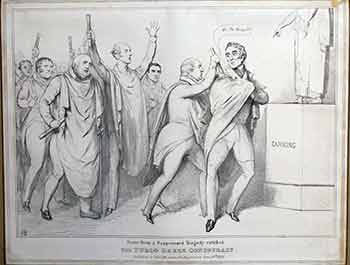
Scene from a Suppressed Tragedy entitled The Turco Greek Conspiracy.
London: Thomas MacLean, 1830. Original lithograph. 14.5 x 11.5 inches. Very Good. Minor spot of foxing at top corner. Inserted into light matting. Published 18 June, 1830.
Sitters: George Canning (1770-1827), Prime Minister. Ulick de Burgh, 1st Marquess of Clanricarde (1802-1874), Statesman. John George Lambton, 1st Earl of Durham (1792-1840), Governor-General of Canada. Charles Grey, 2nd Earl Grey (1764-1845), Prime Minister. Henry Richard Fox (later Vassall), 3rd Baron Holland (1773-1840), Whig statesman and patron of art and letters. Henry Petty-Fitzmaurice, 3rd Marquess of Lansdowne (1780-1863), Whig politician; Home Secretary, Chancellor of the Exchequer and Lord President of the Council. Charles William Vane-Stewart, 3rd Marquess of Londonderry (1778-1854), Soldier and diplomat. Arthur Wellesley, 1st Duke of Wellington (1769-1852), Field Marshal and Prime Minister.
John Doyle (Dublin 1797 – 2 January 1868 London), known by the pen name H. B., was a political cartoonist, caricaturist, painter and lithographer.
In his youth he learned to paint landscapes under Gaspare Gabrielli, and miniature portraits at the Royal Dublin Society's drawing school under John Comerfield. He won a gold medal in 1805. He was commissioned to paint equestrian portraits of the Marquess of Sligo and Lord Talbot, the Irish viceroy, and in 1822 he produced six prints entitled The Life of a Racehorse. That year he moved to London with his wife, Marianna Conan. His painting Turning out the Stag brought him recognition when it was exhibited at the Royal Academy in 1825.
Doyle continued to exhibit miniatures until 1835, but by then he was experiencing greater success with his political cartoons, printed using the new reproductive medium of lithography, beginning in 1827. These were issued once a month during parliamentary sessions, and continued for twenty-two years. His caricatures were mostly faithful likenesses of their subjects, with little exaggeration, treated with sarcastic humor, often alluding to popular plays. They were signed with the letters H. B., constructed out of two Js and two Ds, Doyle's own initials. By 1840 he was prosperous enough to afford a fashionable house in Hyde Park, moving in the same circles as David Wilkie, Walter Scott, Samuel Taylor Coleridge, Charles Dickens, William Makepeace Thackeray, Thomas Macaulay, Thomas Moore and Samuel Rogers – but H. B.'s true identity remained a closely guarded secret until he revealed it in 1843 in a seventeen-page letter to Sir Robert Peel.
In the 1840s, at the height of his popularity, indices of H.B.'s prints were published in The Times and by the publisher McLean, but his reputation faded. His later prints were gentle in their humor and drawn in a soft, indistinct style. Thackeray said his cartoons, although clever and witty, were too "genteel" to raise more than a gentlemanly smile – "You will never hear any laughing at 'H. B.'" When he died in 1868, his obituary in The Art Journal did not appear until three months after his death, and a posthumous sale of his sketches at Christie's in 1882 was canceled for lack of buyers. However, he is considered a founder of the school of British cartoon satirists represented by John Leech, John Tenniel, and his son Richard Doyle, which established the style made famous by Punch magazine. The British Museum has over 900 of his drawings in its collections. Item #17-3397
Price: $150.00
